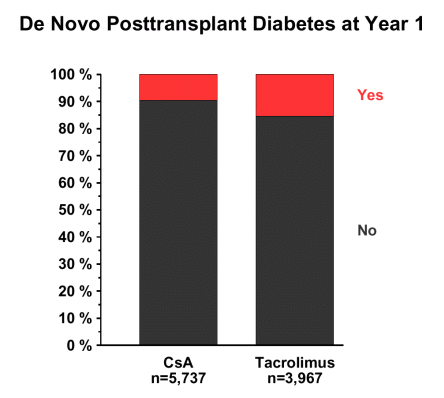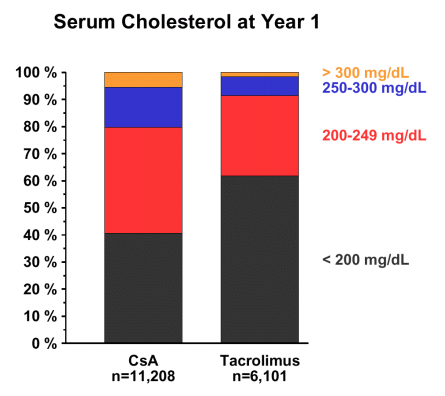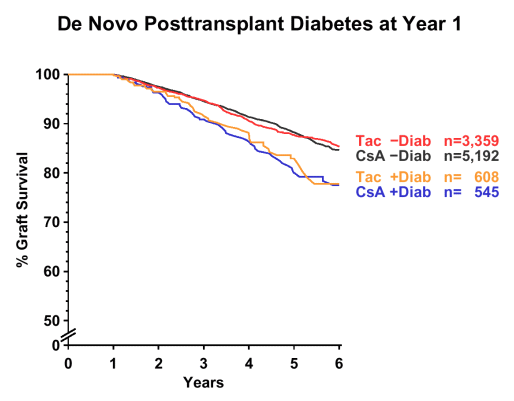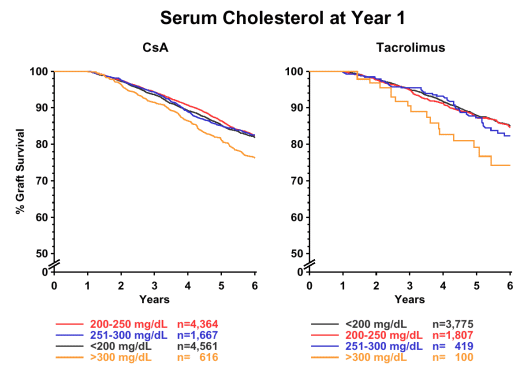
Figure 1
February 1, 2009
The new CTS website update, released concurrently with the appearance of this first newsletter of the year, provides a complete update on the more than 2,000 outcome graphs. A year of follow up has been added and many graphs have been refined. Please use these graphs freely for teaching or presentation at meetings. You can be proud to be a contributor to this invaluable reference source.
In consideration of the presentation of CTS results, I would like to point out that there are three levels of reporting:
Thus the level of statistical reliability increases from the website to the newsletters and further to scientific publications.
In this newsletter, we would like to report to you on an analysis of secondary outcome effects associated with the two main calcineurin inhibitors. It is known from the literature that treatment with cyclosporine (CsA) is associated with a pronounced rate of hypercholesteremia whereas treatment with tacrolimus (Tac) is associated with an increased rate of de-novo posttransplant diabetes. The results reported to the CTS study are summarized in the following figures. Deceased donor kidney transplants performed during the last 10 years were analyzed. Patients were studied according to the intention-to-treat principle (initial immunosuppression).

Figure 1
Figure 1 illustrates that the incidence of de-novo diabetes 1 year posttransplant is considerably higher among patients treated with tacrolimus than among CsA-treated patients. On the other hand, the distribution of serum cholesterol levels 1 year posttransplant is clearly more favorable in tacrolimus patients as compared to patients treated with CsA (Figure 2).

Figure 2
An interesting question, of course, is whether these conditions, which in principle are treatable, have an influence on subsequent graft outcome.

Figure 3
Figure 3 shows that the occurrence of posttransplant de-novo diabetes during the first year is associated with a sizable decrease in graft survival during subsequent follow up. While the influence on outcome is similar regardless of whether recipients developed de-novo diabetes during treatment with CsA or Tac, the fraction of patients with de-novo diabetes contained in this analysis at 1 year was 15.3 % in patients treated with tacrolimus as compared to only 9.5 % in patients with cyclosporine.

Figure 4
Analysis of 1-year total serum cholesterol levels shows decreased graft survival in patients with >300 mg/dL (Figure 4). Here the situation is reversed in that relevant hypercholesteremia was much more frequent among CsA-treated (5.5 %) than tacrolimus-treated patients (1.6 %).
As expected, both hypercholesteremia and de-novo diabetes were found to affect graft as well as patient survival (latter not shown).
We would like to gratefully acknowledge the receipt of 1600 DNA samples and 1700 serum samples with the November shipping cycle for the ongoing collaborative CTS laboratory studies. As always, these contributions are highly appreciated.
The next deadline for shipment of sera and/or DNA is
May 11/12, 2009
Please do not hesitate to contact us if you have any queries in relation to these studies.
Thank you for your support.
With best wishes for a successful continuation of the year 2009,
Sincerely yours,